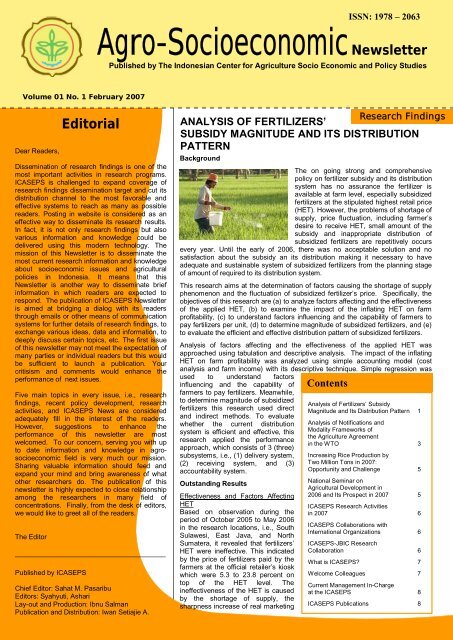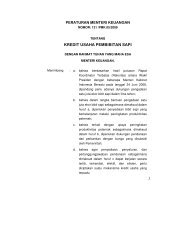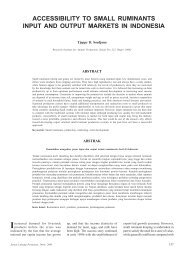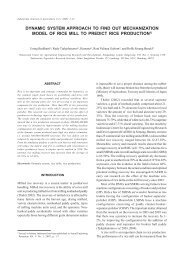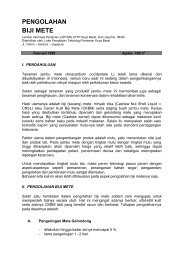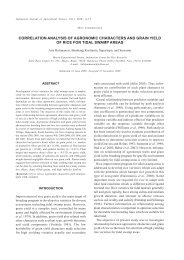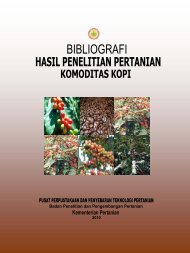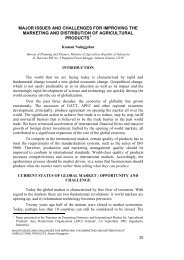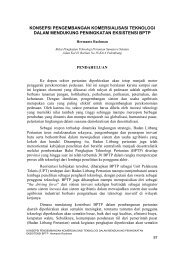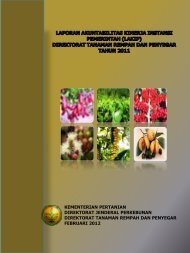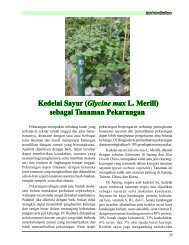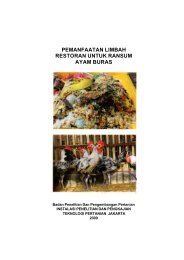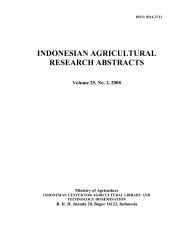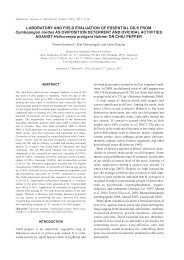Agro-SocioeconomicNewsletter - Pusat Sosial Ekonomi dan ...
Agro-SocioeconomicNewsletter - Pusat Sosial Ekonomi dan ...
Agro-SocioeconomicNewsletter - Pusat Sosial Ekonomi dan ...
- No tags were found...
You also want an ePaper? Increase the reach of your titles
YUMPU automatically turns print PDFs into web optimized ePapers that Google loves.
ISSN: 1978 – 2063<strong>Agro</strong>-Socioeconomic NewsletterPublished by The Indonesian Center for Agriculture Socio Economic and Policy StudiesVolume 01 No. 1 February 2007Dear Readers,EditorialDissemination of research findings is one of themost important activities in research programs.ICASEPS is challenged to expand coverage ofresearch findings dissemination target and cut itsdistribution channel to the most favorable andeffective systems to reach as many as possiblereaders. Posting in website is considered as aneffective way to disseminate its research results.In fact, it is not only research findings but alsovarious information and knowledge could bedelivered using this modern technology. Themission of this Newsletter is to disseminate themost current research information and knowledgeabout socioeconomic issues and agriculturalpolicies in Indonesia. It means that thisNewsletter is another way to disseminate briefinformation in which readers are expected torespond. The publication of ICASEPS Newsletteris aimed at bridging a dialog with its readersthrough emails or other means of communicationsystems for further details of research findings, toexchange various ideas, data and information, todeeply discuss certain topics, etc. The first issueof this newsletter may not meet the expectation ofmany parties or individual readers but this wouldbe sufficient to launch a publication. Yourcritisism and comments would enhance theperformance of next issues.Five main topics in every issue, i.e., researchfindings, recent policy development, researchactivities, and ICASEPS News are consideredadequately fill in the interest of the readers.However, suggestions to enhance theperformance of this newsletter are mostwelcomed. To our concern, serving you with upto date information and knowledge in agrosocioeconomicfield is very much our mission.Sharing valuable information should feed andexpand your mind and bring awareness of whatother researchers do. The publication of thisnewsletter is highly expected to close relationshipamong the researchers in many field ofconcentrations. Finally, from the desk of editors,we would like to greet all of the readers.The Editor_________________________________Published by ICASEPSChief Editor: Sahat M. PasaribuEditors: Syahyuti, AshariLay-out and Production: Ibnu SalmanPublication and Distribution: Iwan Setiajie A.Research FindingsANALYSIS OF FERTILIZERS’SUBSIDY MAGNITUDE AND ITS DISTRIBUTIONPATTERNBackgroundThe on going strong and comprehensivepolicy on fertilizer subsidy and its distributionsystem has no assurance the fertilizer isavailable at farm level, especially subsidizedfertilizers at the stipulated highest retail price(HET). However, the problems of shortage ofsupply, price fluctuation, including farmer’sdesire to receive HET, small amount of thesubsidy and inappropriate distribution ofsubsidized fertilizers are repetitively occursevery year. Until the early of 2006, there was no acceptable solution and nosatisfaction about the subsidy an its distribution making it necessary to haveadequate and sustainable system of subsidized fertilizers from the planning stageof amount of required to its distribution system.This research aims at the determination of factors causing the shortage of supplyphenomenon and the fluctuation of subsidized fertilizer’s price. Specifically, theobjectives of this research are (a) to analyze factors affecting and the effectivenessof the applied HET, (b) to examine the impact of the inflating HET on farmprofitability, (c) to understand factors influencing and the capability of farmers topay fertilizers per unit, (d) to determine magnitude of subsidized fertilizers, and (e)to evaluate the efficient and effective distribution pattern of subsidized fertilizers.Analysis of factors affecting and the effectiveness of the applied HET wasapproached using tabulation and descriptive analysis. The impact of the inflatingHET on farm profitability was analyzed using simple accounting model (costanalysis and farm income) with its descriptive technique. Simple regression wasused to understand factorsinfluencing and the capability offarmers to pay fertilizers. Meanwhile,to determine magnitude of subsidizedfertilizers this research used directand indirect methods. To evaluatewhether the current distributionsystem is efficient and effective, thisresearch applied the performanceapproach, which consists of 3 (three)subsystems, i.e., (1) delivery system,(2) receiving system, and (3)accountability system.Outstanding ResultsEffectiveness and Factors AffectingHETBased on observation during theperiod of October 2005 to May 2006in the research locations, i.e., SouthSulawesi, East Java, and NorthSumatera, it revealed that fertilizers’HET were ineffective. This indicatedby the price of fertilizers paid by thefarmers at the official retailer’s kioskwhich were 5.3 to 23.8 percent ontop of the HET level. Theineffectiveness of the HET is causedby the shortage of supply, thesharpness increase of real marketingContentsAnalysis of Fertilizers’ SubsidyMagnitude and Its Distribution Pattern 1Analysis of Notifications andModality Frameworks ofthe Agriculture Agreementin the WTO 3Increasing Rice Production byTwo Million Tons in 2007:Opportunity and Challenge 5National Seminar onAgricultural Development in2006 and Its Prospect in 2007 5ICASEPS Research Activitiesin 2007 6ICASEPS Collaborations withInternational Organizations 6ICASEPS-JBIC ResearchCollaboration 6What is ICASEPS? 7Welcome Colleagues 7Current Management In-Chargeat the ICASEPS 8ICASEPS Publications 8
Page 2Vol. 01 No. 1 February 2007margin and difficulty tomeet the requirements offertilizers’ HET asobliged by regulationsissued by the Minister ofAgriculture. Shortage ofsupply was happeneddue to very limitedamount of availablesubsidized fertilizerscompared to the volumerequired by the farmers. The sharpness increase of marketingmargin was occurred because of illegal DO (Delivery Order)transaction, profit taking beyond the stipulated fee, illegalretribution along the way of delivery lines, and increasing ofdistribution costs due to the increasing of fuel price in October2005. Meanwhile, difficulty to meet the Minister’s requirementwas appeared because the regulation indicates that HET wouldonly applicable at the official fertilizer’s kiosks, paid in cash, andavailable in 50 kg-package (Urea, SP-36, and ZA), and 50 kg- or20 kg-package for NPK. Majority of farmers asked for latepayment and the amount required was less than the availablepackages.The Impact of Fertilizer’s HET toward Paddy Farm ProfitabilitySimulation results show that the inflating fertilizer’s HET which isparallel with the price of paddy’s HPP would reduce paddy farmnet profit. This indicated by 4.93 of profit reduction for rentedland and similarly 2.50% of profit reduction without rented land.The other indication is that the R/C ratio with rented land was alsoreduced from 1.57 to 1.53 and R/C ratio without rented land from3.50 to 3.39.The increase of fertilizer’s HET along with the increase of paddy’sHPP, either with the same or different percentage would keep theincrease of paddy farm profit. This indicated by the increasingprofit for rented land at about 20.64% and without rented land ataround 10.45%. Similar trend shown by the increasing R/C ratiofor rented land from 1.67 to at least 1.67 and without rented landfrom 3.50 to 3.64.If the government is willingto increase fertilizer’s HETand at the same timewould also like to improvepaddy farm profit, thegovernment shouldincrease the paddy’s HPPwith at least as high as thesame percentage and atthe same time should alsoguaranteetheeffectiveness of fertilizer’s HPP and paddy’s HPP. If thiscondition could be met, the increase of fertilizer’s HET would notdecrease profitability gained from paddy farm as well as thefarmers’ welfare.The Capability of Farmers to Pay the Increasing Fertilizer’s HETThe following is the list of average fertilizers prices that thefarmers could afford in the three study locations should theaggregate fertilizer’s HET increase: Urea (Rp. 1,206.06/kg or14.86% above the applied HET), SP-36 (Rp. 1,512.83/kg or8.06% above the applied HET), ZA (Rp. 1,149.29/kg or 20.98%above the applied HET), and NPK (Rp. 1,673.91/kg or 4.62%above the applied HET). This information means that for SP-36and NPK, fertilizers with relatively high applied HET, thepercentage of the increasing HET that the farmers could afford forthe two fertilizers is relatively low, i.e., 8.06% and 4.62%,respectively. In contrary, for Urea and ZA, fertilizers withrelatively low applied HET, the percentage of the increasing HETthat the farmers could afford for these two types of fertilizers isrelatively high, i.e., 14.86% and 20.98%, respectively.Based on the above mentioned data, the percentage average thefarmers could afford for the inflating HET of the four fertilizers is12.13%. This means that if the government has to increasefertilizer’s HET, the average increase should be 12.13% (thehighest) for the four types of fertilizers.Factors that positively affecting the capability of farmers to copewith higher price rate compared to the applied fertilizer’s HET arefarmer’s age which is the representation of farm experience,formal education attainment indicate the level of farmer’sknowledge in farming system, and income gained from off-farm toshow the availability of working capital. Moreover, the only factoridentified negatively affecting the capability of farmers to copewith higher price rate compared to the applied fertilizer’s HET isthe employed land size representing the farmer’s perception totake farm risk.Magnitude of Fertilizers SubsidyThe required volume of subsidized fertilizers in 2007 based ondirect method – a method considering area target andrecommended fertilizers application – is 8.7 million tons orincreased by 45% compared tothose of 2006. Using indirectmethods – a method consideringfarmer’s response on economicincentives/disincentives andincrement of area andintensification – is laid in therange of 6.2 to 6.3 million tons orincreased by 3.3 to 5.0%compared to those of 2006. Onits increasing percentage, totalrequired volume of subsidizedfertilizers based on indirectmethods is more realistic.Subsidized fertilizers required in 2007, with assumption thatfertilizer’s HPP is increasing by 10% in 2007, would be Rp. 6.7billion for the first scenario (fertilizer’s HET and paddy’s HPP arekept constant), between Rp. 4.0 to Rp. 5.9 billion for the secondscenario (fertilizer’s HET and paddy’s HPP are increasing at thesame rate of percentage), and between Rp. 3.9 to Rp. 5.8 billionfor the third scenario (fertilizer’s HET and paddy’s HPP are bothincreasing at different rate of percentage).Design of Distribution SystemBased on the Ministry of Trade Regulation (Permendag) No.03/M-DAG/Per/2/2006 about the distribution of fertilizers, thecurrent system is practically use passive and semi-closeddistribution system. Some consequences resulted from this typeof distribution system are: vulnerable manipulation of subsidymagnitude at retailer/kiosk level, out of the target, not able tocompete with price dualism, and farmers have tendency to applyfertilizers beyond the recommended amount (over intensification).To deal with the weakness of the current distribution system,active and complete system is suggested to improve the designof subsidized fertilizers management pattern. This systemconsists of (1) delivery system, (2) receiving system compatiblewith distribution system in closed pipe system but managed bytwo different institutions, and (3) accountability system.The increase of fertilizer’s HET by 1% will increase the share offertilizer’s cost on total cost for rented land by 0.08% and on totalcost without rented land by 0.13%. Meanwhile, the increase offertilizer’s HET by 1% will reduce the production of dry shell ofpaddy production by 0.12%. Moreover, the increase of fertilizer’sHET by 1% will reduce paddy farm profit for rented land by 0.49%and that of without rented land by 0.25%.If the government could provide financial support amounted toRp. 5.8 billion for subsidized fertilizers in 2007, with assumptionthat fertilizers HPP will be increased by 10% in 2007, the mostappropriate scenario taken by the government in 2007 is toincrease fertilizer’s HET and paddy’s HPP by 10%, respectively.
Vol. 01 No. 1 February 2007 Page 3With this scenario, theamount of subsidizedfertilizers is around Rp. 5.8billion and the total volumeof subsidized fertilizersprovided by the governmentis 6.307.441 tons or about6.3 million tons which couldbe broken down as follows:Urea 4.509.650 tons or 4.5million tons, SP-36 753.285tons or about 753 thousandtons, ZA 629.894 tons or around 630 thousand tons, and NPK414.612 tons or more or less 415 thousand tons.The distribution system of fertilizers applied currently issuggested to change, from passive and incomplete distributionsystem to active and complete distribution system. This impliesthat the new system will be dealing with a number of weaknessescarried out at the moment, such as: vulnerable manipulation ofsubsidy magnitude at retailer/kiosk level, out of the target, notable to compete with price dualism, and farmers have tendency toapply fertilizers beyond the recommended amount (overintensification).Policy ImplicationsTo avoid ineffectiveness of fertilizer’s HET in 2007, the HETshould be increased because fertilizer’s HET during the last 3(three) years had never been adjusted to the current condition,making it reasonable to increase. The current unrealisticfertilizer’s HET is simply based on the fact that the price of fuelduring the last three years have been increasing several times,while the price of fertilizers where transportation is one of themain cost had never been increased. If the budget for subsidizedfertilizers and the government buying price (HPP) for fertilizers isunchanged, the total volume of subsidized fertilizers is expectedto increase with the increase of fertilizer’s HET. Interesting toknow that the main reason of ineffective fertilizer’s HET is causedby the available volume of subsidized fertilizers is less than thevolume required by the farmers. Moreover, the applied fertilizer’sHET is no longer realistic. In this context, the increasepercentage of fertilizer’s HET should consider the capability offarmers to meet the price. Based on this research finding, theaverage increase of HET for the four types of fertilizers (Urea,SP-36, ZA, and NPK) should no more than12.13%.Since the increase of fertilizer’s HET is surelyreduce paddy farm profit, the governmentshould balance the negative impact caused bythe situation by, at the same time, increasingthe government buying rate (HPP) for paddy atthe same or different rate of percentage as inthe fertilizers. In this connection, thegovernment has an obligation to guarantee theeffectiveness of the paddy’s HPP. If this policyis taken by the government as the permanentprocedure whenever the rate of fertilizer’s HETincrease, the negative impact related to economic, social andpolitical dimensions should be easily encountered. However, it isimportant to note that with this scenario, the government is in noabsolute conduct at any time to freely increase fertilizer’s HET.The percentage increase of fertilizer’s HET should alwaysconsider the capability of farmers to cope with such increase.To ensure the effectiveness of fertilizer’s HET in 2007, the onethat has been increased at farmers’ level, the government has toreplace the current passive and incomplete distribution system offertilizers with that of active and complete one. One of theconsequences of the current passive and incomplete distributionsystem is that the distribution would be out of the target.Therefore, the advantage of the increased fertilizer’s HET wouldpractically enjoyed only by the actors of distribution if noimprovement made to the current fertilizer’s distribution system.In fact, from the government point of view, the target of suchsubsidized fertilizers should be in favor of the farmer, that is toreduce the cost of production and to gain more profit from theirfarm activities.Correspondence: Nizwar Syafa’at (nizwars@yahoo.com)ANALYSIS OF NOTIFICATIONS ANDMODALITY FRAMEWORKS OF THEAGRICULTURE AGREEMENT IN THE WTOBackgroundWTO was formed and started with the aim toward a strong,connected and a sustainable multilateral trading system amongmember countries. The WTO has formulated and produced eithertrade agreements or disagreements, on each round of it’s’negotiations. Related to agriculture, the agreement was called anagreement of agriculture (AoA). AoA was viewed among membercountries as the key issue, and considered to be on the fronttrack of all negotiations. AoA covers three main pillars of issues,namely: (1) domesticsupport, (2) export subsidy,and (3) market access.Those three issues wereintensivelybeingnegotiated and insistedupon by the developingcountries to reach a newtrade deal, through themechanism of special anddifferential treatment.Since the last round ofnegotiations (the UruguayRound) and ten years has passed by, neither significant changenor balanced agreement on agriculture was adopted.Nevertheless, the year OF 2013, was the time-limit agreed bymember countries for modality in the export subsidy’ issue.For Indonesia, it is extremely important to gather and examine allinformation to justify each round of talks. It is also important toanticipate and analyze each of proposals by other countries.Indonesia, being the coordinator of G-33, is also need to prepareits position on the negotiations and anticipatethe impact of various international andmultilateral policies and agreements into its owndomestic agricultural commodities andresources. It also felt the need to look intoimpact of each round of talks/negotiations toother developing countries.Proposal for modalities on each of the threepillars will always be emerged for round oftalks/negotiations. It is important, for Indonesiato analyze and to anticipate the impact of thoseproposals to agricultural development.ICASEPS is interested in studying notificationsand modality frameworks of the AoA in the WTO. Its impact onoverall G-33 countries is also important to be analyzed.Objectivesa. To re-assess proposals on the domestic support cut and toanalyze each impact on agricultural performance, farmers’livelihoods in Indonesia and G-33,b. To examine proposals on the modality on export subsidies andto analyze each impact on agricultural performance, farmers’livelihoods in Indonesia and G-33,c. To analyze proposals of each scheme of tariff cuts that are onthe table recently and identify its impact on agriculturalperformance, farmers’ livelihoods in Indonesia and G-33,
Page 4Vol. 01 No. 1 February 2007d. To formulate policy recommendation related to modalities ondomestic supports, export subsidies, and tariff cuts without anadverse/negative impacts to the agricultural development andlivelihoods of the farmers and society as a whole.Outstanding Results and Policy ImplicationsThe level of domestic support of the Developed Countries (DDC)such as the US, the EU and Japan is in fact higher than those ofthe Developing Countries (DGC) such as Indonesia and the G-33.Soybean and other oilseeds are among the commodities enjoyinga high domestic support in the DDC. The US and Japan pertaintheir domestic supports to their paddy/rice-processed-rice andother cereal grains, while the EU give domestic support to itsplant-based fibers (cotton) commodity. Meanwhile, unlike theDDC countries, Indonesia and G-33 countries do not give highsubsidies/domestic support to their agricultural commodities.Among commodities that are getting the domestic supports arepaddy/rice, wheat, oilseeds, and plant-based fibers.The local government in Indonesia has not been systematicallynoted, calculated and recorded their own and local programs tosupport their agricultural sector, such as replanting, marketingsupport,extension, irigation-maintaining-suppport, into theircalculation of total domestic support. Nevertheless, those totaldomestic support calculations are needed to get the exactnumber of domestic support of the country. Among threecategories in the AoA-WTO round of talks (AMS, Green Box, BlueBox), only the Green Boxmeasurement that hadbeen implemented by thegovernment to increase thedevelopment of theagricultural sector. Thesupport is mainly come inthe form of funds transferfrom the centralgovernment as “dekonsentrasi funds”. This system ofdependency are happening due to the limited funds faced by thelocal government. Therefore, for Indonesia, the position as theDGC countries and member of the WTO with regard to thenotification of its domestic support in AoA, is to :(1) support andmaintain the de minimis level for the DGC countries, and (2)increase its domestic support as categorized in the Green Box,through the increasing of the “dekonsentrasi” transfer funds fromthe central government to the local government.Related to the G-20, the US, the EU, and the Hong KongProposals, on the scenario of domestic support cuts, Indonesiawill be facing the increasing prices of all commodities. Thehighest increased will be on the price ofland (1 percent) and the price ofoilseeds/soybean (2 percent).Indonesia’s volume of import of allcommodities analyzed will be decreased.The highest decreased is on theoilseeds/soybean of -6 to -9 percent. Allother commodities’ prices analyzed aredecreasing less than 1 percent, with theexception of Hong Kong Round’Proposal, for commodities paddy/riceand processed-rice, other cereal grains,vegetable oils and fats, and oilseeds.Total domestic demand on allcommodities will also be decreased, withthe highest decreased is on the demand of oilseeds/soybean at -0,4 to -0,5 percent. The positive impact on Indonesia is on theincreasing demand of the local/ domestic products/commoditiesto substitute the imported ones. It is shown on the increasingdemand of cereals, plant-based fibers, and raw milk-dairyproducts. Meanwhile the positive impact is shown on theimported-demand of horticulture products, animal products, andother crops. The overall impact of the domestic cut’ scenarios onthe Indonesia’ output of rice production, other cereals production(maize, soybean) andplant-based fibersproduction, will increaseat positive 0.02 to 5percent; whereas onwheat, horticulture,sugar and meat-animalproducts,willexperienced adecreasing rate.Therefore, the potentialrate of use of the Indonesia’s resources (either land,labour/employment or other natural resources) allocation onthose commodities are increasing, with the highest rate onoilseeds/soybean of more than 3 to 5 percents. The negative rateis on the commodity wheat due to incompatibility of the tropicalclimate of Indonesia. Other impact observed is on the land-basedresource allocation for paddy/rice, sugar and cattle. In the nearfuture, land use for those commodities will face consequences onthe land availability.The domestic support cut scenarios will have an effect on theGDP of each country, whether classifies as the DevelopedCountries (the US, the EU, Japan, Korea, Australia-New Zealand,etc.) or the Developing Countries-DGC (Indonesia and G33). Theimpact to the national GDP is high and positive for the DevelopedCountries (DDC) such as the US, the EU and others. ForIndonesia, an insignificant and low negative rate (- 0.003) willaffect its GDP. Indonesia’ welfare will also decreased around 18to 22 million $US.Export subsidies of the DDC are higher than the DGC, and theEU dominates the high. Among those commodities that arehaving high subsidies of the EU countries are paddy/riceprocessedrice, wheat, other cereals/grains (maize), sugar,livestock products-cattle. Indonesia and G-33 do not have a highexport subsidies on those commodities, and G-33 countries areonly subsidizing their sugar, vegetable oils and fats, andprocessed food products with low rate.Related to the G-20, the US, the EU, and the HongkongProposals, on the scenario of domestic support cuts shows thatIndonesia will experience the increasing prices of allcommodities. The highest increase of price will be on land (3percent ), wheat (5 percent), rice/paddy (1 percent), maize (2percent), soybean (1 percent), plant-based fibers (1 percent) <strong>dan</strong>cattle (1 percent). Meanwhile the impact of export subsidy cut willdecrease the Indonesia’ import volumes of all commodities, withthe exception on wheat, maize, and other crops. The highestdecreased rate will be faced by sugar,cattle, and raw milk-dairy products at therate from 7 to 23 percent (100%scenario). Other impact detected in thecut scenario is the decreasing rate of landavailability for commodities such aspaddy/rice and plant-based fibers. Itshould be interpreted and seen as therewill be land conversion for those twocommodities.The positive and high impact on the GDPwill be high and be significant only to theDDC countries, such as the EU.Nevertheless, for Indonesia, the decreaseon its GDP is relatively small (- 0,005 to -0,009 percent). Meanwhile, the Indonesian welfare will decreaseat the amount of US$ 68-135 millions.On the assessment of the G-20, the US, the EU, and the HongKong Proposals and carefully looking on each scheme of the tariffcuts, for the G-33 countries: (1) G-20 Proposal or the EUProposals gives relatively even tariff cuts on each band with theexception of the 4th band; (2) ACP Proposal made all tariff cutsemerged in a conical form, with majority cut at the first
Vol. 01 No. 1 February 2007Page 5band/bottom band and small cut at the4th/upper band, (3) Australia , the US, andthe New Zealand tier/band Proposals comein the form of the majority have to be emergein the 2nd and 4th band/tier, whilst theminority or small cuts are in the 3rd and 1stbands/tiers. For Indonesia: (1) the G-20 , theEU, and Australia Proposals willclustered/grouped the major of tariff cut inthe 2nd band/tier, smaller cuts in the 4thband/tier, and smallest or minor cut in the 1stand 3rd band/tier; (2) the ACP Proposal gives almost 90%configurated tariff at the 1st band/tier, with decreasing number ofcuts on subsequently tier/band; (3) the New Zealand Proposalgrouped or clustered the majority of tariffs on the 2nd band/tier(almost 87%), and subsequently conically to the upperbands/tiers. The G-20 or the EU Proposalsspread the tariffs all over the bands evenly,while the Australia-the US- the New Zealand-Proposals distribute the tariffs only at the 2n<strong>dan</strong>d 4th band/tier. Meanwhile ACP CountriesProposal group the tariff cut pyramidally. ForIndonesia and G-33, the Australia and the USProposals will caused drastically cutting thetariffs compare to the EU, the G-20 and theACP Proposals. The New Zealand Proposalshow a lower rate in tariff cut. However theACP Proposal is showing the lowest and very moderate cutamong all Proposals.Correspondence: Budiman Hutabarat(budihutabarat@yahoo.com)Recent Policy DevelopmentINCREASING RICE PRODUCTION BY TWOMILLION TONS IN 2007: OPPORTUNITY ANDCHALLENGEJanuary 2007 mark theissuance of the governmentplan to increase two milliontons of rice during 2007.This endeavor was raised toface a great challenge of ricedeficit to feed the country, letthe additional productiontarget provided locally. Theproduction centers havebeen prepared to participate in the program throughintensification, extensification, the improvement of the farmingsystem, production gui<strong>dan</strong>ce, seed and fertilizers subsidy,production capital, etc.Total production of paddy in 2006 was 54.7 million tons and withthe target of production amounted to 58.4 miilion tons in 2007, theincreasing production of 3.3 million tons is expexted to provide 2million tons of rice. Four main activities to meet this target are:providing sufficient water for irrigation, using high quality of seed,applying balance fertilizers, reducing production losses. Theseactivities are guarded by various means and tools to ensure theright implementation of the program. The government will buyfarmer’s rice production using newly set up purchasingmechanism, decrease the dependency on rice import. Budgetallocated to achieve this target has been provided, amounted to8.7 trillion rupiahs to especially subsidize seed and bank interest,credit assurance, and cost for extension activities.There are 16 provinces included in the program, i.e., Aceh, NorthSumatera, West Sumatera, South Sumatera, Lampung, WestJava, Central Java, East Java, DI Yogyakarta, Banten, Bali, WestNusa Tenggara, West Kalimantan, South Kalimantan, SouthSulawesi, and Gorontalo. Budget allocated for credit has beenprepared by Ministry of Agriculture, i.e., food security credit(KKP/Rp. 3.87 trillion), agricultural budget service scheme(SP3/Rp.1 trillion), rural economic development (LUEP/Rp. 223billion), and agricultural investment credit (Rp. 500 billion) inaddition to 25% of down payment prepared to purchaseagroindustry industrial tools and machineries plus warehousecostscheme.This is an optimistic views to achieve the target, meanwhile thereare also pessimistic of some stakeholders of its failure, taking intoaccount the unpredicted climate condition. The anomaly ofclimate has forced the farmers to delay their seedling andplanting period adjusted to the beginning of rainy season. Theshrinkage of planted area and a high explosion of pest attackcould influence the production. Moreover, the prolong droughtpredicted in 2007 will also affect the production process.Understanding this condition, the focus of production is, therefore,given to seven provinces with target planted area are scatterednearby dams. SouthSumatra, Lampung,West Java, CentralJava, East Java, WestNusa Tenggara andSouth Sulawesi are theregion in which damsare available. About800 thousand ha of wetland or 1.6 million ha ofplanted area in 2007 isexpected to produce 3.26 million tons of paddy or 1.86 milliontons of rice (89.73% of the previous target). And for wateravailability at the dams, the government will provide artificial rain(February to April 2007) to fill in water at the dams for especiallyirrigation during the second planting season of 2007. Small andscattered piece of lands are also provided to keep water forcertain purposes during the drought planting season.Research ActivitiesNATIONAL SEMINAR ON AGRICULTURALDEVELOPMENT IN 2006 AND ITS PROSPECTIN 2007This seminar is organized by the ICASEPS as one of its activitiesto disseminate research results with specifically respond to thelatest stage of national agricultural development activities. Theobjectives aimed at the performance of agricultural developmentfrom the point of view of achievement indicators in 2006 and usethe findings as bases of formulation for operational steps tostrengthen agricultural development in 2007.The seminar was held on 20 December 2007 at the Bumikarsa-Bidakara Hotel in Jakarta and was officially opened with thekeynote speech by Dr. Achmad Suryana, the Director General ofthe Agency for Agricultural Research and Development. It wasattended by researchers, decision makers, agribusinesspractices, representatives from universities, state-ownedenterprises, and NGOs including the national farmers association(HKTI). All papers presented by the ICASEPS’ policy researcherswith critical discussions delivered by the university, professors,journalists, and senior researchers institutes.The topics covers macro indicators of the agriculturaldevelopment in 2006 and 2007, such as poverty alleviation,
Page 6Vol. 01 No. 1 February 2007farmers’ intitutionaldevelopment, and thedevelopment performance ofselected crops. Main resultsof the seminar include theadjustment of developmentdirection to focus on qualityimprovement, social capitaland skills of work force tooptimize utilization oftechnology-based localresources. Macro indicators show that performance ofagricultural development in 2006 is better than 2005. Foragriculture PDB of 2007, budget allocation for agriculturaldevelopment should be increased, for especially expand area ofcultivation and irrigation network development. Meanwhile,agricultual land conversion should also be controlled and thegovernment is suggested to keep the current purchasing baseprice and maintain the highest retail price for fertilizers tointensively adopt agricultural technology.A change of paradigm in agricultural sector to adopt integratedregional development is recommended in the seminar taking intoaccount the share and support of other sectors associated withthe agricultural development. On the operational approach, thelocal government may take this paradigm into their regionaleconomic develoment. For poverty alleviation, a clear separationaspect of target segments of poor people, shifting of partialapproach to carry out multi sector and holistic approach, policysupport, focus of development, and legal aspect development areamong the main issues to be thoroughly considered.ICASEPS RESEARCH ACTIVITIES IN 2007In 2007, ICASEPS has five main programs in its researchactivities, they are:A. Research Program in Macro Economy and International Trade1. “Analysis of Free Trade Agreement between Indonesiaand China and AFTA Cooperation and Its Impact onIndonesian Agricultural Commodity Trade” Team Leader:Dr. Budiman HutabaratB. Research Program in Socioeconomic of AgriculturalResources, Food Security, and Poverty Alleviation2. “Analysis of Feasibility and Perspective of AgriculturalInsurance Development on Paddy and Corn” TeamLeader: Dr. A. Rozany Nurmanaf3. “Analysis of Agricultural Sector Budget Policy” TeamLeader: Dr. Sahat M. PasaribuC. Research Program in Institutional Model Engineering onTechnology Application and Agribusiness4. “Development of PRIMATANI Program”Team Leader: Director of ICASEPS5. “Action Research on StrengtheningAgricultural Community of DisadvantageRegion (Third Phase)” Team Leader: Dr.Edi BasunoD. Research Progam in Estimation and Projectionof Socioeconomic Parameters on Commodities as Rural andAgricultural Development Indicators6. “National Farmer’s Panel (PATANAS): Indicator Analysisof Rural and Agricultural Development” Team Leader: Dr.Bambang Irawan7. “Rural Socioeconomic Dynamics: Comparative Analysison Agriculture Census” Team Leader: Dr. Erna MariaLokollo8. “Profile Analysis of Farmers and Agriculture in Indonesia”Team Leader: Dr. Nyak Ilham9. “Analysis of Fertilizers’ Supply and Demand in Indonesia,2007-2012” Team Leader: Prajogo U. Hadi, SE, MSc.10. “Re-assessment of Fertilizers’ Subsidy and ItsDistribution Policy” Team Leader: Dr. Nizwar SyafaatE. Analysis and Synthesis of Agricultural Development Policy11. “Re-assessment of Agricultural Development Program”Team Leader: Dr. Yusmichad Yusdja12. “Analysis of Agricultural Development Policy: Responseon Actual Issues” Team Leader: Director of ICASEPSICASEPS COLLABORATIONS WITHINTERNATIONAL ORGANIZATIONSICASEPS conduct some research collaboration with domesticand international organizations. This is to accomplish one of theCenter’s vision: to became an international research center thattruly recognized by international organizations. The following aresome of the research collaborations with international institutions.On-going Research Activities (2007):1. “Egg Market in Eastern Indonesia” (IFC-PENSA, World Bank,October 2006-March 2007)2. “Agriculture Sector Study for IFC-SADI” (IFC-PENSA, WorldBank, October 2006-March 2007)3. “Study of Effects of PhysicalInfrastructure on PovertyAlleviation and HumanCapital Outcomes inIndonesia” (JBIC, IFPRI,World Bank, January-June2007)4. The Role of Agriculture inIndonesia: Enhancing theContribution of Agricultureto Poverty Reduction andFood Security” (FAO, January-December 2007)Previous Reseach Activities (2004-2006):1. “Technical Change in Thai and Indonesian Agriculture:Measurement, Socio-Economic Impact and Policy Implication”(ACIAR, June-August 2004)2. “Socio-Economic Assessment Impact of the Avian InfluenzaCrisis on Poultry Production Systems in Indonesia withParticular Focus on Independent Smallholders” (FAO-RAP,August-October 2004)3. “The Rules of Agriculture in Poverty Reduction in Indonesia”(FAO, June 2004-October 2005)4. “Food and Labor Market Analysis and Monitoring Systems inNanggroe Aceh Darussalam (NAD) Province”(WFP/FAO, January-December 2005)5. “Impact of Contract Farming Foreign DirectInvestment on Small Farming in Indonesia”(IFPRI, January-December 2006)ICASEPS – JBIC RESEARCHCOLLABORATIONEffects of Infrastructure Development on RuralCommunity WelfareThis study is a collaborative project between ICASEPS, JBIC,World Bank and IFPRI. The role of physical infrastructures inagricultural development is very strategic. The increasing ofquality and avalability of physical infrastructures in transportationand telecommunication is very helpful to improve the flow ofgoods and services. The physical infrastructure in health field ispre requisite in an effort to increase community health program.Improvement of infrastructures in education field is a basic
Vol. 01 No. 1 February 2007 Page 7element to enhance the capacity of people to master thedevelopment of knowledge and technology. Other infrastructuresare very important in relation with the community welfare,including road connection, housing, and so on.This collaborative research is aimed to understand the effect ofinvestment in infrastructures and its impact on the level of ruralcommunity welfare. Researchers from the three institutions(ICASEPS, JBIC, and IFPRI) are closely working together toaccomplish this study.Correspondence: sonnysumaryanto@yahoo.comICASEPS NewsWHAT IS ICASEPS?ICASEPS is a research institutionin which its mandate is to carry outagro-socioeconomic andagricultural policy analysis inIndonesia. Under the Agency forAgricultural and ResearchDevelopment, ICASEPS as asubsidiary institution of theSecretariat General of Ministry ofAgriculture, serves the national interest in agriculturaldevelopment.ICASEPS is established at its current stand after severaladjustment made to respond to the change in national agriculturaldevelopment trend. Founded in 1976, the Center was earlierknown as the Center for <strong>Agro</strong>-Economic Research with majorityof its human resources was sent to study in country and abroad.The office title was replaced by the Center for <strong>Agro</strong>-Socioeconomic Research (in 1990) to accommodate socialaspects in its research agenda, and Center for <strong>Agro</strong>-Socioeconomic Research and Development (in 2001) toaccommodate development in its research mandate. Only afterseveral thoughts and anticipation to respond to future trend thatthe current name is adjusted to particularly give more rooms andenlarge its capacity to conduct studies on agricultural policy(2005). Seven directors had served the Center over 30 yearssince its establishment, they were Prof. Dr. Sjarifuddin Baharsjah(1976-1983), Dr. Faisal Kasryno (1983-1989), Dr. EffendiPasandaran (1989-1995) Dr. Achmad Suryana (1995-1998) Dr.Tahlim Sudaryanto (1998-2002), Dr. Pantjar Simatupang (2002-2005). After several positions in the Ministry of Agriculture, theincumbent Director, Dr. Tahlim Sudaryanto was re-assigned andtaking his second term to lead the Center (2005-now).ICASEPS has 121 researchers consists of 27 Doctoral degree,51 Master degree, and 43 Sarjana equal to bachelor degree. TheCenter is also served by 107 supporting staff who are mainlyworking on computer center and other administrative affairs.Duty and FunctionICASEPS duty is to conduct analysis and assessment on socialeconomic and agricultural policies issues.Functions of ICASEPS are: (a) to formulate social economicanalysis and agricultural policies; (b) to conduct study on socialeconomic and agricultural policies; (c) to conduct reassessmentof programs and policies of agricultural issues; (d) to offertechnical services in social economic analysis and agriculturalpolicies; (e) to conduct research collaboration, to utilize analysisand assessment results, and to implement public consultancy insocial economic aspects and agricultural policies; (f) to evaluateand to report studies and assessment on social economic andagricultural policies; and (g) to manage administration andgeneral affairs of the center.VisionICASEPS vision is to become an international, decisive, reliableresearch center in generating agricultural social-economicinformation and sciences, and to be proactive in recommendingalternative agricultural development policies.MissionTo conduct analysis and assessment to produce agriculturalsocial-economic information and sciences as the primaryproducts of the center.To conduct policies analyses, namely to process information andsciences of the analysis results into alternative recommendationsof agricultural development policies.To advocate agricultural development through public campaign tomobilize participation of related institutions and the community insupporting agricultural development.To develop institutional capacity of the center to accomplish itsvision and mission.WELCOME COLLEAGUESDoctoral degree is the highest academic achievement one couldobtain. ICASEPS is very thankful to welcome back two of itsresearchers who have awarded their doctoral degree at IPB,Bogor.Dr. Nyak IlhamDissertation title: “Efektivitas Kebijakan HargaPangan terhadap Ketahanan Pangan <strong>dan</strong>Dampaknya pada Stabilitas <strong>Ekonomi</strong> Makro”(Effectivity of Food Price Policy and Its Impact onMacro Economic Stability), 4 December 2006.Dr. Reni KustiariDissertation title: “Analisis <strong>Ekonomi</strong> tentangPosisi <strong>dan</strong> Prospek Kopi Indonesia di PasarInternasional” (Economic Analysis on Positionand Prospect of Indonesia’s Coffee inInternational Market), 30 January 2007On this educational attainment, Prof. IsangGonarsyah of IPB expresses his feeling by sayingthat intellectual community has its freedom to serve according toits capacity and background of his/her interest. Lately, theinteraction between researchers and politicians has becomingjeopardize with certain tendency of people involved to take themost advantageous opportunity for his/her own short-termbenefit. As a consequence, a paralysis of analysis could not beavoided as it will serve only the interest of certain group ofcommunity. In this respect, neither solve the people’s problemsnor the integrity of the researchers-politicians but the creation ofmore pitfalls.On this context, Dr. F. A. Bernado (1982) said, as quoted by Prof.Isang Gonarsyah when he delivered his speech at Reni Kustiari’sfinal examination: “Evaluation of research performance may bedone by colleagues, external party and end-users of researchresults. The colleagues viewpoints tend to be largelycomplementary, the external party’s, at times biting; and the endusersresoundingly final, though often made in silence. Glory bethose who pass the end-users’ judgement. So, know specially thepeople you serve. They are the reasons for your being, themeasure of your relevance”.
CURRENT MANAGEMENT IN-CHARGE ATTHE ICASEPSDr. Tahlim Sudaryanto (Director, tahlim@indo.net.id)Dr. Nizwar Syafa’at (Division Head, Research AnalysisUtilization and Dissemination, nizwars@yahoo.com)Dr. Handewi P. Saliem (Division Head, Research Program andEvaluation, hps0406@yahoo.com)Mr. Rudy S. Rivai (Division Head, Administrative Affairs,rudysunarya@yahoo.com)Mr. Iwan Setiajie Anugrah (Chief Section, Dissemination andPublication, publikasi_psekp@yahoo.co.id)Mrs Wahida (Chief Section, Research Collaboration Services,wahida@indosat.net.id)Mr Supena Friyatno (Chief Section, Research Program,supenaØ1@yahoo.com)Mrs. Erma Suryani (Chief Section, Research Evaluation,erma_pse@yahoo.com)Mrs. Yuni Marisa (Chief Section, Personnel and Housekeeping)Mr. Agus Subekti (Chief Section, Budgeting and Properties)Research Groups :1. Agricultural Economics and Agribusiness ManagementChairperson : Dr. Handewi P. SaliemE-Mail : hps0406@yahoo.com2. Macro Economics and International TradeChairperson : Dr. M. Husein SawitE-Mail : mhs@indo.net.idmhsawit@yahoo.com3. Socio-cultural of Rural AgricultureChairperson : Dr. Edi BasunoE-Mail : edi_basuno@yahoo.comICASEPS PUBLICATIONSICASEPS has several publications. Four of them are publishedregularly, i.e., Jurnal <strong>Agro</strong> <strong>Ekonomi</strong> (<strong>Agro</strong> Economic Journal)and Forum <strong>Agro</strong> <strong>Ekonomi</strong> (<strong>Agro</strong> Economic Forum) whichpublished twice a year (May and October and July andDecember, respectively), Analisis Kebijakan Pertanian(Agricultural Policy Analysis) published four times a year(March, June, September, and December), and <strong>Agro</strong>-Socioeconomic Newsletter which published every two months(Feb, April, June, August, October, and December)The irregularly publications are specifically provided anddisseminated according to its purpose. To mention some ofthem: working paper, monograph which will be replaced byProceeding of Research Results Seminar, Proceeding ofNational Seminar, Thematic Books, Leaflet/Booklet, andEnglish version of Selected Publications.The Center also provide various information in its website(http://pse.litbang.deptan.go.id) for public services. The websiteis planned to be improved. Meanwhile, the agro-socioeconomicdatabase is currently under re-construction to simplify andeasier retrieval of the data. The main purpose of the databaseimprovement is to serve more domestic and international users.Correspondence AddressJalan Ahmad Yani 70Bogor 16161IndonesiaPhone No. +62251333964Fax No. +62251314496E-mail: publikasi_psekp@yahoo.co.idWebsite: http://pse.litbang.deptan.go.idIndonesian Center for Agriculture Socio Economic and Policy StudiesJalan Ahmad Yani 70Bogor 16161IndonesiaSTAMP


